

Views Our Perpetual Ocean. Ocean Color Image Gallery. Scripps Institution of Oceanography, UC San Diego. Ocean Color Image Archive Page. NOTE: All SeaWiFS images presented here are for research and educational use only.
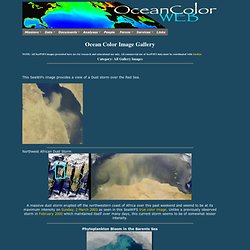
All commercial use of SeaWiFS data must be coordinated with GeoEye Category: All Gallery Images This SeaWiFs image provides a view of a Dust storm over the Red Sea. Northwest African Dust Storm. Marine Stewardship Council - home. Protecting the World's Oceans. 5 Gyres – Understanding Plastic Pollution Through Exploration, Education, and Action. Climate Change, Deforestation, Biomes and Ocean Currents, Plankton, Endangered Species - Earth Web Site. Click for more detail Thermohaline Change Evidence is growing that the thermohaline current may be slowed or stopped by cold fresh water inputs to the Arctic and North Atlantic oceans.

This could occur if global warming is sufficient to cause large scale melting of arctic sea ice and the Greenland ice sheet. Sea Shepherd. Baltic Sea Action Group. Outreach and education at ESR. Global Fishing Watch. We’re hooked on this map of industrial fishing. Smile! Satellites can see your illegal fishing from space. If a fish falls in the forest and no one is there to hear it … wait, is that not how it goes?
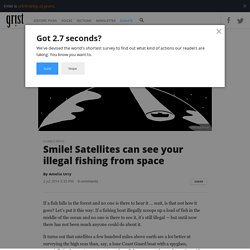
Let’s put it this way: If a fishing boat illegally scoops up a load of fish in the middle of the ocean and no one is there to see it, it’s still illegal — but until now there has not been much anyone could do about it. It turns out that satellites a few hundred miles above earth are a lot better at surveying the high seas than, say, a lone Coast Guard boat with a spyglass, especially in the most remote waters where fishermen may be used to acting with impunity — ignoring quotas, transferring fish from ship to ship, dumping bycatch, even changing the vessel’s name between ports like a Shakespearian youth slipping casually into drag.
The Plan to Map Illegal Fishing From Space. Illicit fishing goes on every day at an industrial scale.

The Magazine - A Fish Story. May/June 2012A Fish Story How an angler and two government bureaucrats may have saved the Atlantic Ocean.
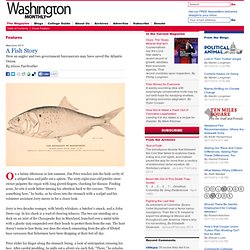
By Alison Fairbrother On a balmy afternoon in late summer, Jim Price reaches into the body cavity of a striped bass and pulls out a spleen. The sixty-eight-year-old jewelry-store owner palpates the organ with long gloved fingers, checking for disease. Finding none, he sets it aside before turning his attention back to the carcass. Overfishing 101: How Ocean Fish Populations are Managed in the U.S. – National Geographic News Watch. In the second post of a special series to mark the 35th anniversary of the U.S.
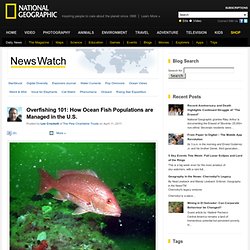
Magnuson-Stevens Fishery Conservation and Management Act, a law that is helping to rebuild America’s depleted ocean fish populations and ensure their long-term sustainability, Lee Crockett looks at some of the basics of why all Americans should care about how our fish are managed. Why Are Millions Of Fish Suddenly Dying In Mass Death Events All Over The Planet? Michael SnyderActivist Post Millions upon millions of fish are suddenly dying in mass death events all over the world, and nobody seems to know why it is happening.
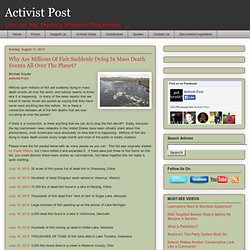
In many of the news reports that are linked to below, locals are quoted as saying that they have never seen anything like this before. So is there a connection between all of the fish deaths that are now occurring all over the planet? If there is a connection, is there anything that we can do to stop the fish die-off? Sadly, because the big mainstream news networks in the United States have been virtually silent about this phenomenon, most Americans have absolutely no idea that it is happening. Please share the list posted below with as many people as you can. -July 18, 2013: 20 acres of fish ponds full of dead fish in Shandong, China. Shark Trust. SHARKWATER. Whale shark slaughterhouse exposed in China. Seismic.surfrider.org. Main Page - Coastal Wiki. Ocean Pollution 1. Gulf Oil Spill Cleanup Ends As BP Pulls Out, Leaves Unanswered Questions. McDonald's ocean rescue: Sea change or greenwash?
6 October 2011Last updated at 08:19 By Kate Forbes BBC News Experts seem to think the little blue label can have a big impact.

The Cove Movie: Welcome. Oceans. Food, work, fun, adventure, sport and life – not many things can give us all those things in one.

Every day the oceans give us the air we need to breathe; the weather to grow crops; water to support the smallest to the largest animals on earth and 80% of all species; vast ice flows to help regulate our climate; millions of jobs and a life-time of pleasure. Send us your favourite ocean image and it could be featured here! You and I are alive right now because of the oceans. There is no other place in the universe so full of life as this planet; so green, so rich in diverse, beautiful, weird and wonderful, large and small species, on land and at sea and it is all because Planet Earth is Planet Ocean. They are home to the largest animal our planet has ever known – the now-endangered blue whale - but there are still huge areas of ocean that humans have never seen.
Dolphin safe label. The concept of dolphin-safe tuna labeling originates in the United States.[1] The labels have become increasingly controversial since their introduction, particularly among sustainability groups in the U.S.
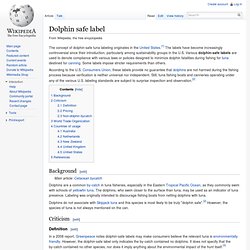
Various dolphin-safe labels are used to denote compliance with various laws or policies designed to minimize dolphin fatalities during fishing for tuna destined for canning. Some labels impose stricter requirements than others. According to the U.S. Consumers Union, these labels provide no guarantee that dolphins are not harmed during the fishing process because verification is neither universal nor independent. Still, tuna fishing boats and canneries operating under any of the various U.S. labeling standards are subject to surprise inspection and observation.[2] Background[edit] Dolphins are a common by-catch in tuna fisheries, especially in the Eastern Tropical Pacific Ocean, as they commonly swim with schools of yellowfin tuna. Criticism[edit] Greywater Recycling. Future Society & Enviroment.